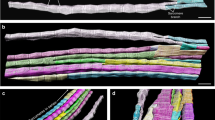Abstract
In vertebrate skeletal muscles, the architecture of myofibrils is particularly well conserved throughout the taxa. It is composed of suites of repeating functional units called sarcomeres which give the muscle its striated structure. Here, we show that the skeletal sound producing muscles of the cusk eel Parophidion vassali have a different organisation, distinct from the classical type found in textbooks. Within sarcomeres, filaments are not straight lines but have a Y-shaped structure. This looks like chicken wire, with one branch connecting to a branch from the myofibril above and the other connecting to a branch from the myofibril below. This organisation seems to be an adaptation to counteract a trade-off between the speed and force. The low ratio of myofibrils within cell muscles and the high volume of sarcoplasmic reticulum strongly suggest that these muscles are capable of fast contractions. In parallel, the Z-bands are quite wide about 30% of the sarcomere length. This extraordinary long Z-band could smooth out the tension variations found in high-speed muscle contraction, helping to produce sounds with low variabilities in the sound features. Simultaneously, the Y-shaped structure allows having more cross-bridges, increasing the force in this high-speed muscle.



Similar content being viewed by others
Data availability
Available underlying data will be provided upon reasonable request.
References
Banse M, Chagnaud BP, Huby A et al (2021) Sound production in piranhas is associated with modifications of the spinal locomotor pattern. J Exp Biol 224. https://doi.org/10.1242/jeb.242336
Burgoyne T, Heumann JM, Morris EP et al (2019) Three-dimensional structure of the basketweave Z-band in midshipman fish sonic muscle. Proc Natl Acad Sci 116:15534–15539. https://doi.org/10.1073/pnas.1902235116
Connaughton MA (2004) Sound generation in the searobin (Prionotus carolinus), a fish with alternate sonic muscle contraction. J Exp Biol 207:1643–1654. https://doi.org/10.1242/jeb.00928
Eichelberg H (1976) The fine structure of the drum muscles of the tigerfish, Therapon jarbua, as compared with the trunk musculature. Cell Tissue Res 174:453–463
Eichelberg H (1977) Fine structure of the drum muscles of the piranha (Serrasalminae, Characidae). Cell Tissue Res 185:547–555. https://doi.org/10.1007/bf00220658
Fine ML (2012) Swimbladder sound production: the forced response versus the resonant bubble. Bioacoustics 21:5–7
Fine ML, Burns NM, Harris TM (1990) Ontogeny and sexual dimorphism of sonic muscle in the oyster toadfish. Can J Zool 68:1374–1381
Fine ML, Malloy KL, King C et al (2001) Movement and sound generation by the toadfish swimbladder. J Comp Physiol - A Sensory, Neural, Behav Physiol 187:371–379. https://doi.org/10.1007/s003590100209
Huxley AF, Niedergerke R (1954) Structural changes in muscle during contraction: interference microscopy of living muscle fibres. Nature 173:971–973. https://doi.org/10.1038/173971a0
Huxley H, Hanson J (1954) Changes in the cross-striations of muscle during contraction and stretch and their structural interpretation. Nature 173:973–976. https://doi.org/10.1038/173973a0
Kilarski W (1967) The fine structure of striated muscles in teleosts. Z Zellforsch Mikrosk Anat 79:562–580
Lewis MK, Nahirney PC, Chen V et al (2003) Concentric intermediate filament lattice links to specialized Z-band junctional complexes in sonic muscle fibers of the type I male midshipman fish. J Struct Biol 143:56–71. https://doi.org/10.1016/S1047-8477(03)00121-7
Luther PK, Munro PMG, Squire JM (1995) Muscle ultrastructure in the teleost fish. Micron 26:431–459. https://doi.org/10.1016/0968-4328(95)00015-1
Millot S, Parmentier E (2014) Development of the ultrastructure of sonic muscles : a kind of neoteny ? BMC Evol Biol 14:1–9. https://doi.org/10.1186/1471-2148-14-24
Parmentier E, Fine ML (2016) Fish sound production: insight. In: Suthers R, Tecumseh F, Popper AN, Fay RR (eds) Vertebrate sound production and acoustic communication. Springer, New York, pp 19–49
Parmentier E, Marucco Fuentes E, Millot M et al (2020) Sound production, hearing sensitivity, and in-depth study of the sound-producing muscles in the cowfish (Lactoria cornuta). J Anat 238. https://doi.org/10.1111/joa.13353
Parmentier E, Stainier G, Boistel R et al (2022) Sound production and mechanism in the cryptic cusk-eel Parophidion vassali. J Anat n/a: https://doi.org/10.1111/joa.13691
Rall JA (2018) What makes skeletal muscle striated? Discoveries in the endosarcomeric and exosarcomeric cytoskeleton. Adv Physiol Educ 42:672–684. https://doi.org/10.1152/advan.00152.2018
Rome LC, Cook C, Sym DA et al (1999) Trading force for speed: why superfast crossbridge kinetics leads to superlow forces. Proc Natl Acad Sci U S A 96:5826–5831. https://doi.org/10.1073/pnas.96.10.5826
Rome LC, Lindstedt SL (1998) The quest for speed: muscles built for high-frequency contractions. News Physiol Sci 13:261–268
Squire J (2019) Special Issue: The actin-myosin interaction in muscle: background and overview. Int J Mol Sci 20:5515
Acknowledgements
David and Gérard Carrodano (http://poissons-vivants.com/) kindly helped with specimen capture. Profs D. Adriaens, A. Herrel, and M.L. Fine made constructive and helpful comments on the MS.
Funding
This work was financially supported by the Fonds De La Recherche Scientifique (FNRS), grant/award number: T.0192.20.
Author information
Authors and Affiliations
Corresponding author
Ethics declarations
Ethical approval
All procedures were approved by the ethical commission of the University of Liège (ethics case 1759).
Consent to participate
Not applicable.
Conflict of interest
The authors declare no competing interests.
Additional information
Publisher's Note
Springer Nature remains neutral with regard to jurisdictional claims in published maps and institutional affiliations.
Rights and permissions
Springer Nature or its licensor (e.g. a society or other partner) holds exclusive rights to this article under a publishing agreement with the author(s) or other rightsholder(s); author self-archiving of the accepted manuscript version of this article is solely governed by the terms of such publishing agreement and applicable law.
About this article
Cite this article
Parmentier, E., Thiry, M. A new organisational design in skeletal muscle fibres. Cell Tissue Res 393, 111–117 (2023). https://doi.org/10.1007/s00441-023-03775-5
Received:
Accepted:
Published:
Issue Date:
DOI: https://doi.org/10.1007/s00441-023-03775-5




